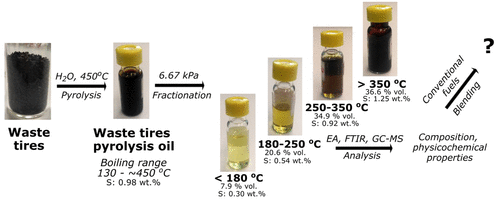当前位置:
X-MOL 学术
›
Energy Fuels
›
论文详情
Our official English website, www.x-mol.net, welcomes your
feedback! (Note: you will need to create a separate account there.)
Pyrolysis Oil from Scrap Tires as a Source of Fuel Components: Manufacturing, Fractionation, and Characterization
Energy & Fuels ( IF 5.2 ) Pub Date : 2020-03-30 , DOI: 10.1021/acs.energyfuels.0c00265 Mariusz Wądrzyk 1, 2 , Rafał Janus 1, 2 , Bartłomiej Rządzik 1 , Marek Lewandowski 1, 2 , Stanisław Budzyń 1
Energy & Fuels ( IF 5.2 ) Pub Date : 2020-03-30 , DOI: 10.1021/acs.energyfuels.0c00265 Mariusz Wądrzyk 1, 2 , Rafał Janus 1, 2 , Bartłomiej Rządzik 1 , Marek Lewandowski 1, 2 , Stanisław Budzyń 1
Affiliation

|
One of the most efficient among the methods of managing waste tire rubber is the pyrolysis process which allows for obtaining pyrolysis oil. The as-received, raw tire pyrolysis oil (rTPO) is a complex mixture whose components exhibit a wide boiling temperature range, reflected in the physicochemical properties influencing injection, combustion, performance, and emission. The present contribution is aimed at producing TPO via steam-assisted pyrolysis followed by its fractionation by vacuum distillation. The resultant TPO fractions were analyzed in terms of composition as well as physicochemical parameters. The products are liquids with a relatively high density, poor volatility, and satisfactory low-temperature properties. They exhibit a mutually similar chemical composition reflected in a roughly the same Watson factor. The dominant components are cyclic and aromatic compounds, as was proven by gas chromatography coupled to mass spectrometry analysis and mid-infrared Fourier transform spectroscopy. Such a characteristic of the TPO fractions opens the way to utilize them either as additives to conventional automotive fuels or for heat and power generation. In particular, the two lightest fractions demonstrate high potential as fuel additives. Among the advantages of the fractionation of rTPO, one of the most important is the effect of the accumulation of sulfur-containing compounds in the highest boiling fractions, namely, vacuum fractionation allowed for reduction of the S content by 69.6 and 43.5 wt % (with regard to the rTPO) for the fractions boiling up to 180 and 180–250 °C, respectively. Thus, fractionation of pyrolysis oils could be used also as an ingenious and effective pretreatment method prior to exact desulfurization.
中文翻译:

来自废轮胎的热解油作为燃料成分的来源:制造,分馏和表征
在处理废旧轮胎橡胶中,最有效的方法之一是允许获得热解油的热解过程。最初收到的生轮胎热解油(rTPO)是一种复杂的混合物,其成分具有很宽的沸腾温度范围,反映在影响喷射,燃烧,性能和排放的物理化学性质上。本发明旨在通过蒸汽辅助的热解,然后通过真空蒸馏进行分馏来生产TPO。根据组成以及理化参数分析所得的TPO馏分。该产品是具有相对较高的密度,较差的挥发性和令人满意的低温性能的液体。它们表现出彼此相似的化学组成,反映出大致相同的沃森因数。气相色谱,质谱分析和中红外傅里叶变换光谱已证明,主要成分是环状和芳香族化合物。TPO馏分的这种特性为将其用作常规汽车燃料的添加剂或用于热力发电提供了途径。特别地,两个最轻的馏分显示出作为燃料添加剂的高潜力。在rTPO分馏的优点中,最重要的一项是最高沸点馏分中含硫化合物的积聚效果,即真空分馏可将S含量降低69.6和43.5 wt%(关于rTPO)分别沸腾至180和180-250°C的馏分。从而,
更新日期:2020-03-30
中文翻译:

来自废轮胎的热解油作为燃料成分的来源:制造,分馏和表征
在处理废旧轮胎橡胶中,最有效的方法之一是允许获得热解油的热解过程。最初收到的生轮胎热解油(rTPO)是一种复杂的混合物,其成分具有很宽的沸腾温度范围,反映在影响喷射,燃烧,性能和排放的物理化学性质上。本发明旨在通过蒸汽辅助的热解,然后通过真空蒸馏进行分馏来生产TPO。根据组成以及理化参数分析所得的TPO馏分。该产品是具有相对较高的密度,较差的挥发性和令人满意的低温性能的液体。它们表现出彼此相似的化学组成,反映出大致相同的沃森因数。气相色谱,质谱分析和中红外傅里叶变换光谱已证明,主要成分是环状和芳香族化合物。TPO馏分的这种特性为将其用作常规汽车燃料的添加剂或用于热力发电提供了途径。特别地,两个最轻的馏分显示出作为燃料添加剂的高潜力。在rTPO分馏的优点中,最重要的一项是最高沸点馏分中含硫化合物的积聚效果,即真空分馏可将S含量降低69.6和43.5 wt%(关于rTPO)分别沸腾至180和180-250°C的馏分。从而,











































 京公网安备 11010802027423号
京公网安备 11010802027423号